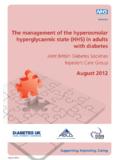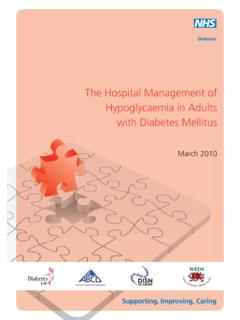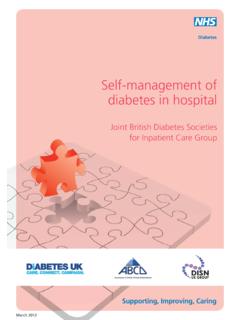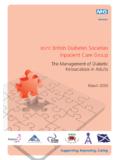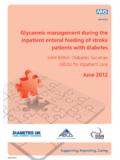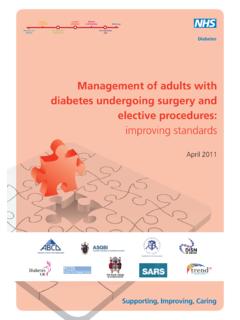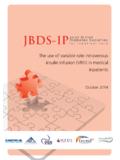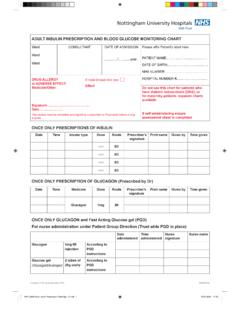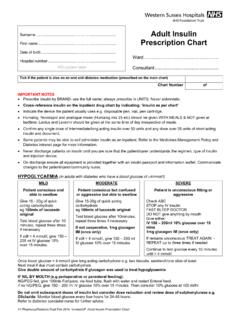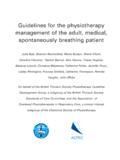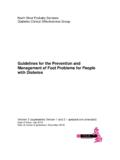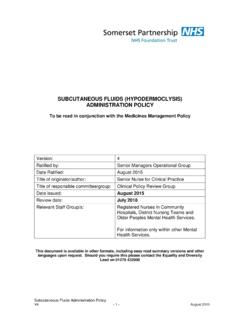Transcription of Joint British Diabetes Societies Inpatient Care Group
1 Joint British Diabetes Societies Inpatient care Group The Management of Diabetic Ketoacidosis in Adults Second Edition Update: September 2013. This document has been endorsed by the Intensive care Society This document is coded JBDS 02 in the series of JBDS documents Other JBDS documents: The management of the hyperosmolar hyperglycaemic state (HHS) in adults with Diabetes . August 2012 - JBDS 06. Glycaemic management during the Inpatient enteral feeding of stroke patients with Diabetes . June 2012 - JBDS 05. Self-management of Diabetes in hospital. March 2012 - JBDS 04. The management of adults with Diabetes undergoing surgery and elective procedures: improving standards. April 2011 - JBDS 03. The hospital management of hypoglycaemia in adults with Diabetes mellitus. Revised September 2013 - JBDS 01. These documents are available to download from the ABCD website at and the Diabetes UK website at Revision Group Lead authorship Dr Ketan Dhatariya, Norfolk and Norwich University Hospital nhs foundation trust Dr Mark Savage, Bendigo Health, Australia Supporting organisations Tracy Kelly, Diabetes UK.
2 Professor Mike Sampson (Norwich), Joint British Diabetes Societies (JBDS) Inpatient care Group Chair Esther Walden (Norwich), Diabetes Inpatient Specialist Nurse (DISN) UK Group Chair Dr Chris Walton (Hull), Association of British Clinical Diabetologists (ABCD) Chair Writing Group Anne Claydon, Barts Health NHS trust Dr Philip Dyer, Heart of England nhs foundation trust Dr Philip Evans, Pontypridd and Rhondda NHS trust Dr Atir Khan, Hywel Dda Health Board Dr Anne Kilvert, Northampton General Hospital NHS trust Dr Nicky Leech, The Newcastle upon Tyne Hospitals nhs foundation trust Dr Nicholas Levy, West Suffolk Hospitals nhs foundation trust Dr Gerry Rayman, The Ipswich Hospitals NHS trust Dr Alan Rees, Cardiff and Vale University Health Board Dr Maggie Sinclair-Hammersley, Oxford University Hospitals NHS trust Thanks also to: Northern Irish Diabetologists Society of Acute Medicine Welsh Endocrine and Diabetes Society Scottish Diabetes Group We would also like to thank the service user representatives whose input has informed the development of these guidelines.
3 With special thanks to Christine Jones (DISN UK Group administrator, Norwich) for her administrative work and help with these guidelines and with JBDS IP. JBDS IP Group gratefully acknowledges the funding and administrative support from NHS Diabetes . 3. JBDS IP Review Group Dr Belinda Allan, Hull and East Yorkshire Hospital NHS trust Dr Hamish Courtney, Belfast Health and Social care trust , Northern Ireland Dr Ketan Dhatariya, Norfolk and Norwich University Hospitals nhs foundation trust Dr Daniel Flanagan, Plymouth Hospitals NHS trust June James, University Hospitals of Leicester NHS trust Tracy Kelly, Diabetes UK. Dr Rif Malik, King's College Hospital nhs foundation trust Dr Colin Perry, NHS Greater Glasgow and Clyde Dr Gerry Rayman, The Ipswich Hospitals NHS trust Dr Stuart Ritchie, NHS Lothian Dr Aled Roberts, Cardiff and Vale University NHS trust Professor Mike Sampson (Norwich), Joint British Diabetes Societies (JBDS) Inpatient care Group Chair Dr Maggie Sinclair-Hammersley, Oxford University Hospitals NHS trust Debbie Stanisstreet, East and North Hertfordshire NHS trust Dr Jonathan Valabhji, National Clinical Director for Obesity and Diabetes Esther Walden, Norfolk and Norwich University Hospital nhs foundation trust Dr Chris Walton, Hull and East Yorkshire Hospital NHS trust Dr Peter Winocour, East and North Hertfordshire NHS trust This document has been endorsed by the Intensive care Society British Society of Paediatric Endocrinology and Diabetes (BSPED)
4 Guidelines for the management of DKA in young people under the age of 18 years can be found at: 4. Contents Page Foreword 6. Introduction 8. Rationale for best practice 10. Controversial areas 13. Serious complications of DKA or its treatment 16. DKA pathway of care 17. Implementation and audit 23. References (in the on-line edition only). Appendices 24. 1. Conversion to subcutaneous insulin 2. Joint British Societies Audit Standards 5. Foreword Diabetic ketoacidosis (DKA), though preventable, remains a frequent and life threatening complication of type 1 Diabetes . Unfortunately, errors in its management are not uncommon and importantly are associated with significant morbidity and mortality. Most acute hospitals have guidelines for the management of DKA but it is not unusual to find these out of date and at variance to those of other hospitals. Even when specific hospital guidelines are available audits have shown that adherence to and indeed the use of these is variable amongst the admitting teams.
5 These teams infrequently refer early to the Diabetes specialist team and it is not uncommon for the most junior member of the admitting team, who is least likely to be aware of the hospital guidance, to be given responsibility for the initial management of this complex and challenging condition. To address these issues the Joint British Diabetes Societies (JBDS), supported by NHS Diabetes , has produced this revision of the 2010 guidance developed by a multidisciplinary Group of practicing specialists with considerable experience in this area. Where possible the guidance is evidence based but also draws from accumulated professional experience. A number of modifications have been made including addition of the criteria to define resolution of DKA and the option to continue human basal insulins in patients who normally take these to manage their day-to-day Diabetes . The management is clearly presented and divided into a number of key steps in the care pathway; the first hour, the next six hours, next twelve hours etc.
6 Importantly, conversion to subcutaneous insulin and preparing for discharge home are included. Audit is encouraged against defined standards. The guideline is clearly written and accompanied by a practical and easy to follow flow chart to be used in admitting departments and wards managing DKA. Also included online in the update is an example of an Integrated care Pathway, this can be modified for local use and is not presented as a fait accompli. The authors should be congratulated on their achievement. These guidelines are recommended to all Diabetes hospital teams for rapid introduction and for acceptance as the national guideline for managing DKA. Their widespread introduction should significantly improve the care of people admitted with DKA. Since this guideline was launched in March 2010, over 5000 copies of the guidelines have been distributed by NHS Diabetes , with countless more being downloaded from the website.
7 In addition, the subsequent publication in Diabetic Medicine (Savage MW et al, Diabetic Medicine 2011;28(5):508-515). has been cited numerous times. Furthermore in the 2012 National Diabetes Inpatient Audit 170 of 216. hospitals reported introducing new DKA guidelines with the majority adopting or modifying the JBDS. guidelines. Dr G Rayman NHS Diabetes Clinical Lead for Inpatient Diabetes care March 2013. 6. Acronyms: NPSA National Patients Safety Agency ISPAD International Society for Pediatric and Adolescent Diabetes BSPED British Society of Paediatric Endocrinology and Diabetes FRIII Fixed rate intravenous insulin infusion VRIII Variable rate intravenous insulin infusion 7 The references can be found in the on-line version of this document at or Introduction There are several currently available national and in accumulation of large quantities of ketone international guidelines for the management of bodies and subsequent metabolic acidosis.
8 Diabetic Ketoacidosis (DKA) in both adults and Ketones include acetone, 3-beta-hydroxybutyrate, children 1-6. and acetoacetate. The predominant ketone in DKA. is 3-beta-hydroxybutyrate. In the last decade, however, there has been a change in the way patients with DKA present DKA has been considered to be indicative, or even clinically and in addition there has been rapid diagnostic, of type 1 Diabetes , but increasingly development of near-patient testing technology. there are cases of ketone-prone type 2 Diabetes Until recently there was no easily available assay being recognised. However, the initial treatment is for ketone bodies hence capillary glucose, venous the same. pH and bicarbonate were used to diagnose and There are several mechanisms responsible for fluid monitor response to treatment in DKA. depletion in DKA. These include osmotic diuresis Near patient testing for 3-beta-hydroxybutyrate is due to hyperglycaemia, vomiting - commonly now readily available for the monitoring of the associated with DKA - and eventually, inability to abnormal metabolite allowing for a shift away take in fluid due to a diminished level of from using glucose levels to drive treatment consciousness.
9 Electrolyte shifts and depletion are decisions in the management of DKA. in part related to the osmotic diuresis. These guidelines have been developed to reflect Hyperkalaemia and hypokalaemia need particular the development in technology and reflect new attention. practice in the UK. They are evidence based where possible but are also drawn from accumulated Epidemiology professional knowledge and consensus agreement. They are intended for use by any health care The true incidence is difficult to establish. professional that manages DKA in adults. Population based studies range from to 8. episodes per 1,000 patients with Diabetes 8,9. Definition and diagnosis DKA remains a significant clinical problem in spite of improvements in Diabetes care 10,11. In the USA. DKA consists of the biochemical triad of the prevalence has risen 12, whilst mortality has ketonaemia (ketosis), hyperglycaemia, and fallen 13,14.
10 Importantly however, the 2012 National acidaemia. Diabetes Inpatient Audit also found that a large number of people developed DKA whilst already in Pathophysiology hospital, thus this complication is not just found at Diabetic ketoacidosis (DKA) is a complex the front door' 15. disordered metabolic state characterised by hyperglycaemia, acidosis, and ketonaemia. DKA Mortality and morbidity usually occurs as a consequence of absolute or An improved understanding of the relative insulin deficiency that is accompanied by pathophysiology of DKA together with close an increase in counter regulatory hormones ( , monitoring and correction of electrolytes has glucagon, cortisol, growth hormone, resulted in a significant reduction in the overall catecholamines). This type of hormonal imbalance mortality rate from this life-threatening condition. enhances hepatic gluconeogenesis and Mortality rates have fallen significantly in the last glycogenolysis resulting in severe hyperglycaemia.
